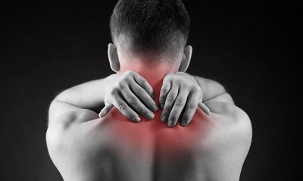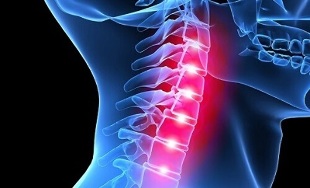
Have you ever had cervical pain, dizziness, nausea or shortness of breath? All these are signs of osteochondrosis of the neck.
Osteochondrosis, a common problem, worries more and more people every year. Can cervical osteochondrosis be cured? First, let's understand the factors of occurrence and the signs of occurrence.
Stages of osteochondrosis
Osteochondrosis of the cervical spine is a disease whose effect weakens the discs between the vertebrae, leading to changes in the structure of the discs, vertebrae and joints of the neck.
In the first stage, the symptoms are almost invisible, as the changes in the cartilaginous vertebrae have just begun. The following symptoms are observed:
- Headache.
- Unpleasant sensations in the neck, arms, shoulders.
- Slight limitation of neck motor activity.
- Short-term visual impairment.
- Reduces the sensitive area of the collar.
During the second stage, a small spinal hernia may occur, and the intervertebral fissures may narrow. Due to the compression of the nerve trunks, point pain syndromes are felt during the performance of the movements.
Manifestations of the disease:
- The neck hurts and a crunch is heard during turns.
- Loss of skin sensation on the hands and shoulders.
- The vision is diminishing.
- I hear a ringing in my ears.
- The face and neck tingle;
- Upper limbs weaken.
- Shooting pains radiating to the shoulder blade.
- Insomnia, sleep problems.
The third stage is difficult to treat. A hernia is formed, the spine is deformed, the position changes, vertebral dislocations are observed:
- Severe pain in the neck, heart muscle, collar area.
- The skin on the head, shoulders, arms ceases to be felt.
- Upper limbs are paralyzed.
- Tendon reflexes are no longer visible.
- A cervical hernia begins.
The fourth and final stage, during which the symptoms worsen.
Causes
Factors influencing the onset and development of cervical osteochondrosis:
- Heavy weight.
- Sedentary work, lack of mobility.
- Previous spinal injuries.
- Mental disorders, nervous tension, stress.
- Poor physical training.
- Spinal curvature, scoliosis, improper posture.
- Incorrect body positions that have become a habit.
- Tension on the neck, back, through work.
- Hereditary predisposition.
- Physical stress, unusual for the body, increased activity.
- Violation of the rules of a healthy diet.
The cervical spine experiences increased stress, which the neck muscles try to balance due to the influence of the factors mentioned above. Muscle spasm occurs, the blood circulation of the body is disturbed. Anatomical lesions appear.
Symptoms of the disease
The symptoms of osteochondrosis of the cervical spine differ from the symptoms of this disease observed in other parts of the spine. The close location of the cervical vertebrae leads to compression of the nerve roots and spinal cord.
I'm experiencing the following symptoms:
- Localization of pain: in the neck, back of the head, shoulder, arms and legs. During the connection of the nerve roots with the process, discomfort is felt in the shoulders, the back of the head, the restructuring of the upper limb begins. Spasm of the neck muscles in the back of the head leads to impaired blood flow.
- Weakness of the arms caused by root dysfunction that involves the motor nerves that repair the muscles of the arms.
- There is a restructuring of the hands due to reduced sensitivity in the hands, damage to the root, which involves the sensory nerves.
- There is pain and a crunching sound during head movements. It is caused by damage to the small joints of the neck, reducing the level of the intervertebral disc.
- Lack of strength, fatigue, dizziness, lack of coordination. Due to the displacement of the vertebrae, the artery of the spine is compressed. This leads to deterioration of blood flow, weakening of the blood supply to the occiput, cerebellum.
- Complication of vision, the tongue loses sensitivity.
The symptoms of cervical osteochondrosis in women are similar to men. At the age of 46-60, the fairer sex turns to stone, tingling in hands during sleep.
Why osteochondrosis is dangerous

The disease damages the whole organism. The cervical region includes a significant number of arteries, nerve endings, blood vessels that feed the brain.
Tightly pressed, due to the slightest pathology, they compress, which leads to deterioration of blood circulation to the brain, causes migraines, heart rhythm disturbances, difficulty in breathing, vision, coordination and attention.
Pathologies that cause osteochondrosis of the cervical spine:
- Brain disease;
- spinal artery syndrome;
- Spinal stroke.
Death is the worst consequence of spinal cord compression.
When all the symptoms of cervical osteochondrosis are considered, the factors for its development are identified, we will consider the treatment used in this case.
Treatment
The treatment of cervical osteochondrosis in women is no different from the treatment in men. Stages of treatment:
- Pain relief.
- Eliminates swelling.
- Normalize blood circulation.
- Strengthen the muscles of the back, abdomen, chest.
- Improved nutrition and tissue repair.
Each stage or symptom should seek medical attention. Specialists choosing complex treatment: surgeon, neurologist, physiotherapist, masseur. Drug therapy, physiotherapy, massage of the collar are used, therapeutic exercises are recommended, as it is effective in osteochondrosis.
Preparation
Medicines used for treatment:
- Medicines that relieve muscle spasms.
- Vitamins that improve metabolism in the nervous system.
- NSAIDs drugs that reduce pain, relieve inflammation and swelling.
- Preparations for joints, cartilage tissue repair, injuries of intervertebral discs.
- Drugs that improve the nutrition of damaged nerve cells regulate blood flow to the brain.
First aid for exacerbations
There are times when the pain becomes unbearable and a visit to the doctor should be postponed. It is recommended to drink painkillers. To relieve the pain, you can apply a "pepper patch", but it is worth noting that you can not hope for a long-term effect. The plaster warms the inflamed area and temporarily relieves the pain. To relieve puffiness, it is recommended to use herbal infusions for 3-4 days. Is it possible to cure cervical osteochondrosis with these methods? No, the above methods are short-term, for full recovery you should consult a doctor.
Physiotherapy
- Electrophoresis- the ions of the anesthetic drug penetrate the inflamed area due to the action of electric current. It is often done with painkillers.
- Laser therapy- has anti-inflammatory properties, ensures improved blood circulation by exposure to light.
- Magnetic therapy- relieves swelling of tissues, has an analgesic effect.
- Ultrasound- there is an improvement in metabolic processes, pain relief, relief of inflammation of the damaged areas.
Therapeutic gymnastics
When it comes to physiotherapy, there are a few simple exercises you need to know. Regular exercise will bring the expected results very quickly.
Attention!When performing the complex, you should not feel pain, discomfort.
- Lie on your stomach, arms outstretched. Keep your back straight while lifting your head and body. Hold the position for about 2 minutes, then take the starting position. Continue the exercise 2-3 times.
- Take a reclining position on the floor, stretch your arms across your body, trying to touch your ear to the floor by turning your head to the left. Perform 6-7 repetitions.
- Inhale while sitting on the floor, lean forward, trying to touch your chest with your head. After exhaling, lean back, throw your head back. Do 10-15 reps.
- Pressing your forehead, lower it to your palms while sitting on the floor. Perform for about 30 seconds, 2-3 repetitions.
- Circular rotation of the head. Perform smoothly, slowly, so that your head begins to rotate. If dizziness occurs, complete gymnastics. Make 10 turns in each direction.
Home treatment
This method of treatment should only be used in conjunction with the complex prescribed by your doctor. In such cases are used: traditional medicine, therapeutic gymnastics, massage.
Recipes for relieving malaise at home:
- A horseradish leaf attached to a neck and secured with a bandage or towel will help. It is recommended to pour boiling water and then cool to room temperature. It is better to leave the bandage overnight.
- Cut the potatoes, mix with honey (one to one). Use once a week as a compress.
- Warming up will help relieve the pain. You can apply mustard plaster, sandbag, pepper plasters, etc.
We advise you not to seek help from forums, you should rely on the diagnoses made by doctors.
Massage

Therapeutic massage can be performed at home, includes elements of classical massage. It starts with a healthy part of the body, gradually moving to the sore spot. The complex is selected for the individual characteristics of the patient, stage of the disease. To perform the massage, the patient must take a horizontal position on the floor, lowering his forehead to his hands and pulling his chin to his chest. Relax the neck muscles.
Massage healing techniques:
- Start massaging with strokes that start from the collar area.
- Push-ups, to perform the masseur puts his hand on his neck and moves along the spine. Alternatively, this technique can be performed to the shoulder.
- Rubbing is done to warm the muscles of the neck, while the body relaxes, bleeding improves. Starting from the skull, the movements are directed, the movements are oriented to the spine.
- The neck should be mixed in a circular motion.
- You need to finish with a vibration done by tapping and shaking.
Prevention
The following rules must be followed to prevent disease:
- Do sports (swimming is most effective).
- Increase your intake of foods containing calcium, magnesium.
- Warm up several times a day, especially if you have a sedentary job.
- Choose the right pillow (should be low) and mattress (should not be soft). Monitor the position of the neck while sleeping: the angle of the neck should be at least 15 degrees.
- Take a hot shower for at least 10 minutes a day.
- For people who do not like sports, experts advise to practice yoga regularly.
- It's better to give up the gym. Bodybuilding can worsen health.
Osteochondrosis and pregnancy
How to treat osteochondrosis while carrying a child? Of course, you need to limit yourself to drug use. Ointments with natural composition and folk methods help.Don't forget!All possible effects on the neck area (eg warming up) are prohibited during pregnancy.
Does osteochondrosis occur in young people? No matter how much adults are convinced that it is too early for adolescents to acquire such diseases, they are observed more and more often. It can develop as a result of congenital or acquired cartilage failure.
During the exacerbation of the disease, it is forbidden to heat the neck, because this can lead to increased swelling.
This article discusses not only the basic concepts, but also effective methods for the treatment of cervical osteochondrosis. They will help you cope with painful sensations, to feel comfortable and confident wherever you are.

























